Divided we stand
The population of Muslims will match the population of Jews in the US by 2030. Will they have a strong influence?

Divided we stand
He is not unique, but rather one of those many Pakistanis who, while they may be physically living in the US, are mentally still in Pakistan. He works more than 10 hours a day and often finds time to chat with a friend after he finally parks his cab for the night. The near-daily shenanigans in Pakistan’s political arena provide the material and set the duration and volume level of these otherwise short and hasty meetings.
“Last time Chaudhry Wajahat came here he appointed me the PML-Q secretary general of the Virginia Chapter. We arranged a get together in his honour. After all, I am from Gujrat,” he says proudly while taking a sharp turn on Pennsylvania Avenue.
Chaudhry Shahzad is also proud of having organised a rally in favour of General Pervez Musharraf, when the latter arrived at the White House a few years ago. The number of participants in that pro-Musharraf rally was around 20, but they still outnumbered the rival group present outside the White House that same day, who were holding placards cursing Musharraf.
Ripples in local, state or federal tiers of American politics do not excite Shahzad. The Tea Party isn’t a political movement for him but rather an occasion to serve samosas. On the other hand a scandal involving some local politicians of his hometown is certain to put a spark in his eye. He seldom reads The Washington Post or The New York Times, but never forgets to get a copy of his favourite community newspaper, which is published in Urdu.
All in all, he’s a fairly typical specimen of the roughly 253,000 Pakistanis (2004 US Census figures) currently residing in the US. In total, legal Pakistanis make up about 0.1 per cent of the total US population.
The immigration phenomenon is deeply rooted in the history of this country, often knows as the Country of Immigrants. Modern novels like American Chica by Marie Arana and The Godfather by Mario Puzo have focused on the intricacies of this subject. The first generation of immigrants always finds it difficult to develop a sense of association with or devotion to the countries they immigrate to. But in case of many first generation Pakistani-Americans, they simply don’t want to even give it a try.
Many Pakistanis living in the US are the sole breadwinners of their families. Some own multi-million dollars mansions near the Potomac River, while some share a dingy room with two of their compatriots in the suburbs of Washington DC. Some are rich, while most face a daily struggle to survive, make ends meet and hopefully send some money back to their families. They hail from all parts of Pakistan and speak many different languages, and they all owe a debt to their adopted country. But there’s one more thing they have in common: they are not an organised community.
New York City hosts the largest concentration of Pakistani-Americans, with a population of approximately 35,000, residing primarily in the boroughs of Queens and Brooklyn. These numbers make Pakistani-Americans the fifth largest Asian-American group in New York City. The states of California and Texas have the largest number of Pakistanis compared to other US states.
The Pakistani community in America is generally regarded as economically successful. Many Pakistani-Americans have managed to increase their wealth and now own their own businesses, including restaurants, grocery, clothing and appliance stores, newspaper booths, and travel agencies. Every year Pakistani-American doctors (more than 15,000 doctors of Pakistani descent are practicing medicine in America) exhibit their wealth by organising mega-events and fundraisers. They give till it hurts: according to Adil Najam, author of the book Portrait of a Giving Community: Philanthropy by the Pakistani-American Diaspora, in the year 2002 the Pakistani community gave nearly $1 billion in charity.
But by and large, the Pakistani community in the US remains disorganised, and the economic clout and credentials of many Pakistani-Americans have contributed little towards converting them into a united body willing to safeguard the interests of their motherland. They are deeply concerned about Pakistan and very vocal in their views. But for one reason or another, their well-intentioned efforts don’t translate into a good deal of influence over American policy makers, nor do they manage to give common Americans a new and positive perspective on Pakistan. Wealthy Pakistanis do randomly organise fundraisers for their American politician friends, but cannot match the networking of Indian entrepreneurs and well-off Indian-Americans.
Living far from the motherland, some Pakistani-Americans have fallen victim to disillusionment. At a recent reception, hosted by a Pakistani-American doctor, a heated debate erupted. A small group was bitterly criticising politicians and proposing “a permanent military rule in Pakistan until things get better.” The other group, looking rather apologetic, was putting up a feeble defense in favour of the much-maligned politicians.
During the last round of Strategic Dialogue between Pakistan and the United States, held in Washington DC, a visiting Pakistani minister had to confront several tough questions from the community. At a dinner reception, the host had to rescue the minister when he was facing the ire of some angry Pakistani-American doctors.
Pakistani journalists and scholars have their own interpretation of the situation. According to their more or less similar analyses, the Pakistani community remains mired in trivial internal disputes instead of thinking or behaving like representatives of a country. They often cite the example of the lobbying success of the Jewish community and its unparalleled power in America.
According to one estimate, the population of Muslims will match the population of Jews in the Unites States by 2030. Would they have as strong an influence on American policy as the Jewish-Americans do? It’s doubtful. Power and influence isn’t a numbers game and in contrast to the relative unity of the Jewish and Indian communities, the Muslim and Pakistani communities remain divided and parochial in their outlooks.
Published in The Express Tribune, Sunday Magazine, February 13th, 2011.


















COMMENTS
Comments are moderated and generally will be posted if they are on-topic and not abusive.
For more information, please see our Comments FAQ